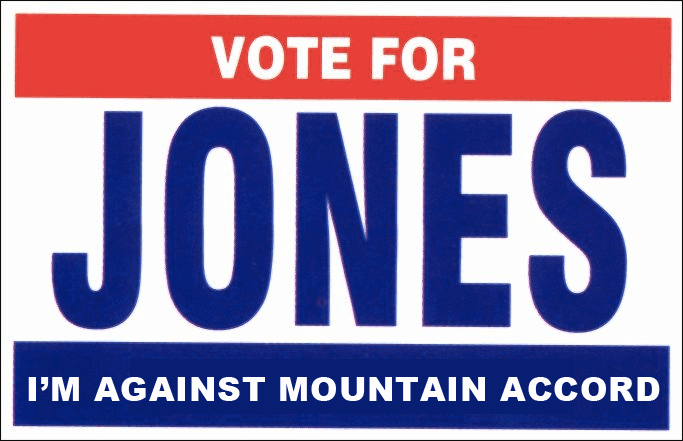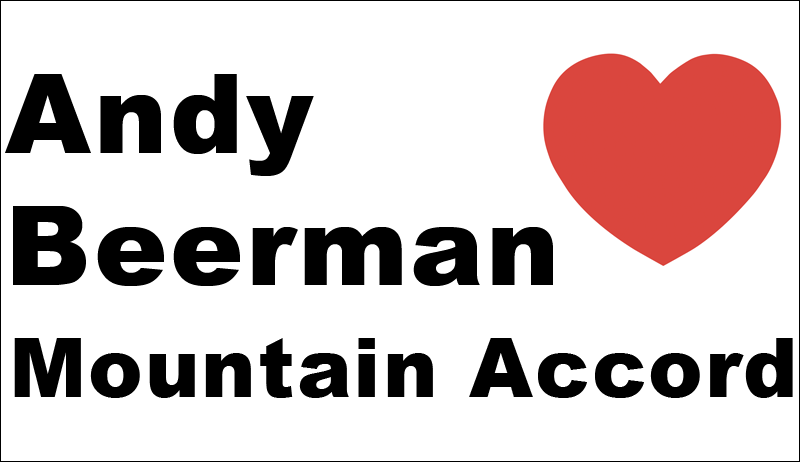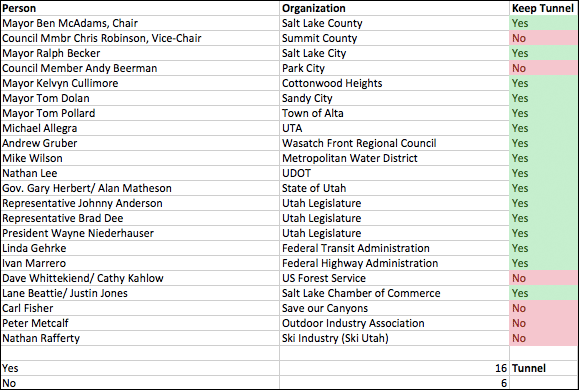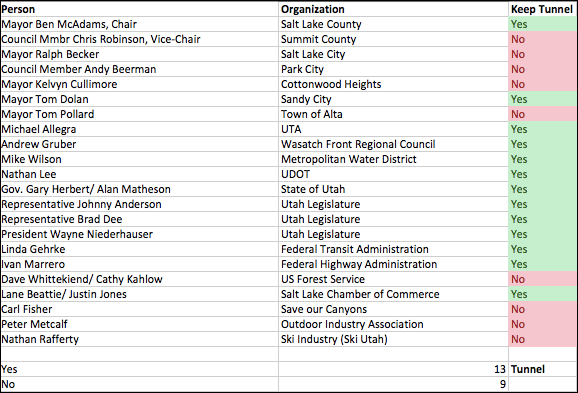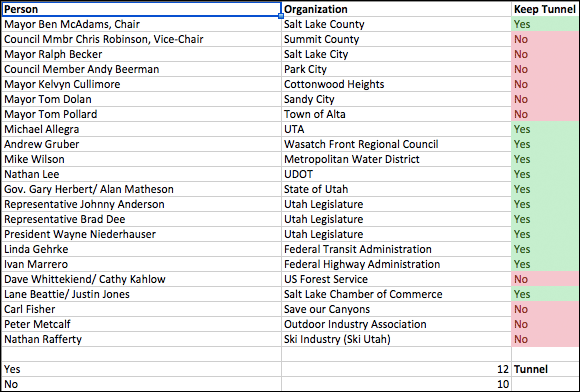What if Mountain Accord Was a New Restaurant
This morning City Council member Liza Simpson was on KPCW again saying that we need to continue to sit at the table so we can see what Mountain Accord really is. All I could think of was, “what if Mountain Accord was a restaurant in Park City?”. Would this fly? Would they get a second… third… fourth chance? You be the judge.
Let’s say someone opened up a new Mexican Restaurant in town. They publicize the hell out of it. They built it at a prominent and beloved place to locals. They make promises that this is going to change the way Parkites look at food. They’ve held focus groups and brought in celebrity chefs to make the perfect menu. They’ve gotten the Park Record to write 5 stories about how the restaurant is truly remarkable.
You decide to go. When you arrive in the parking lot you look up and see the 60 foot tall building. A look of confusion runs across your face as the mountains you love are no longer visible. You ask why it’s so tall and the manager says, “we have to have cliff divers.”
The restaurant opens its doors and the locals flood in to try the hot spot. Well they try to. Once they get inside they find it’s a 2 hour wait. The restaurant had also ran advertisements in Salt Lake and offered free busing to anyone in Utah who wanted to come try the food. They had to maximize the crowd.
Once you are seated you look at the menu. Tacos cost $30 and burritos are $60. When you ask why it cost so much, the server says that you need to look at the ingredients. Parkites are saving the indigenous American Wagyu cattle by only using real Japanese Wagyu cattle. The server tells you, “you are paying a little more to save those American Wagyu” but they must be saved. “Do you want the American Wagyu to die?”
After ordering, you wait. 20 minutes. 30 minutes. 40 minutes. You ask your server, “what’s taking so long?”. The server explains that like Chile en Nogada, that every dish is a slow process. Meanwhile, the cliff divers have started and water is everywhere. You’re soaked.
You finally get your meal and it is OK. It’s worse than Billy Blancos but some parts are better than Del Taco.
You and your partner decide it’s time to leave and ask for the check. They forgot to tell you that margaritas are $25 too. $300 later, you head for the door. Or should I say the gift shop that you have to exit through. You notice a t-shirt that exclaims “try our 15 locations throughout the Salt Lake Valley.” So much for being unique and about Park City.
You finally get to your car and head home vowing that you will never come back and that it was one of the worst restaurant experiences you have ever had. You wonder how something so promising could have turned out so bad. You drift off to sleep and one word comes to mind. GREED.
The next week, you see an ad and accompanying story in the Park Record about 2 for 1’s at the restaurant and how you should come back. The ad says that you have to come back and see what the restaurant is becoming … its great. The article tells you that you just don’t understand the restaurant and you just don’t understand what they are trying to do.You are lying to yourself. You are an idiot. This restaurant is the best thing ever. Just come back a few more times and sit at the table. Come back and see what the restaurant really is.
You stare back into that newspaper article and say, “I don’t need to come back and sit at the table. I already know what it is.”
You know that the faster that restaurant closes and gets torn down, the faster a better restaurant will come in that actually meets the needs of its customers… AND NOT ITS OWNERS.
The Utter Dominance of the Car in Commuting and How It Impacts Park City
Vox has an interesting article talking about the single-occupant car. It opens, “In small pockets of large cities around America, a growing number of people have been walking, biking, or taking public transit to work in recent years. A disproportionate focus on these cities has led advocates and journalists to celebrate the resurgence of car-free forms of transportation. But the researchers who study overall commuting data see things very differently. The dominant mode of travel, by far, is the single-occupant automobile … and the car shows no signs of going away.”
The article speaks to a number of issues, including the demise of the carpool and the fact that car ownership is rising in low-income populations. It also shows that only about 5.5% of people bike or use public transit to go to work. This includes major metropolitan areas.
I believe this impacts Park City for two reasons. It shows that on average we could only expect 5.5% of our residents to commute on public transportation and probably less because our congestion/population doesn’t mimic a city like New York and our weather can be rough. Second, visitors who are used to driving will usually either drive here to Park City or rent a car. I believe public transit is a mindset and if you don’t have it at home, you likely won’t have it when you visit here.
This isn’t to say public transit is a lost cause but it’s likely just a small part of our solution… something like 10-15% as best. The question is whether that’s enough “to solve our problems” or do we also need to be focusing on something else. And if we should also be focusing on something else, do we put all our eggs in one (transportation) basket.
PSA: Another WordPress Vulnerability
Last week I wrote about a couple vulnerabilities impacting computers around Park City. It looks like there is another big one this week.
If your company or organization uses WordPress for your website, your technical people need to do a couple of things to stop your site from being taken over by bad guys (or someone in the PC Caps Hacker Program… Do they have one of those?)
Salt Lake Running Company Takes Over Park City Trail Series
KSL is reporting that Salt Lake Running Company has acquired the Park City Trail Series which utilizes the trails around round valley for 4 races throughout the summer. There aren’t much details as of now about any changes. The series is capped at 500 runners and registration starts May 10th.
Hate the Mountain Accord? Vote Andy Beerman and Liza Simpson Out of Office in November
As you probably have gathered, I don’t like the Mountain Accord. I like the idea of protecting our wilderness and watersheds. However, I think the Mountain Accord is a transportation plan foisted upon us, and has provided little specifics on any environmental gain it would provide to the residents of Summit County or Utah.
I’ve avoided the local politics of it all, as I think the issue itself should have the focus. Yet, I am starting to think that time has passed. Today I read a Park Record Guest Editorial from city council person Liza Simpson. She attacked a local person for writing an editorial to the Park Record on the Mountain Accord. Throughout her editorial she states facts that the individual said, offers her opinion, and then says that the individual really knows that she is right.
What are the statements that she disputes from the individual’s editorial?
- She says that nothing about the Mountain Accord has been fast. She describes it as moving at almost a glacier’s pace.
- She says that the Mountain Accord could be the biggest agreement ever to protect wildlife and watershed that this state has ever seen.
- She states that “In my experience, the Executive Team and the consultants have been very willing to hear diverse viewpoints. I have never gotten the whiff from anyone involved that there was a predetermined outcome.
So, is that true?
- Has the Mountain Accord been moving at a glacier’s pace? Umm … they started in January 2014 and tried to get public input by the end of the year, in order to start a federal process shortly after, for a plan that would completely alter both the front and back of the Wasatch? Summit County couldn’t even get animal control ordinances changed in that amount of time. Yes, that’s fast.
- Is this the biggest environment plan the state has ever seen? I really have no idea on that. It seems likely that the debate over U.S. Forest Service land was probably been bigger but I’m not sure. Yet, the real question is where are the specifics on the watersheds and wildlife in the Mountain Accord plan? There are specifics on the train company that will transport people up little cottonwood. What greater percentage of the “watershed” are we saving? How much purer is it? How much longer will it last? How many animals will likely be saved? Which ones? Just give me a ballpark.
- Was there a pre-determined outcome for the Mountain Accord? Look back to the meeting notes from the October 31st meeting where a County Council member said that he was told that the transportation committee members should vote for Options A or D that had been presented. Is that a predetermined outcome? You decide.
Yet, who am I to tell you how to feel about the Mountain Accord? Unlike Ms. Simpson, with the individual she referenced in her editorial, I don’t presume to know what you know or feel.
What I do know is that if you are against the Mountain Accord, you have an option. You can vote Ms Simpson and Andy Beerman, who also seems to be a staunch supporter of the Accord, out of office in November. They will tell you that they just want to study the concept more. I’ll tell you that the Mountain Accord has little if any potential positive impact on Park City. What are they going to study… whether UTA will agree to build a light rail around Park City, if we’ll allow a tunnel or two? That sounds like a pact with the governor’s office of economic development the Devil.
I suggested this to a prominent member of the community a few days ago. He said, “yeah, but will anyone run against them?”. He has a good point but I think all it would take is for someone to run on a simple anti-Mountain Accord campaign. The candidate would be against the tunnel and therefore against Mountain Accord as it stands. They would paint the picture that Andy Beerman and Liza Simpson are for the tunnel… well … because they seem to want to continue with the Mountain Accord as it.
If Mr. Beerman and Ms. Simpson want the Mountain Accord to continue and are willing to risk a tunnel being forced on us, that’s fine. That said, citizens do have a right to take matters into their own hands… and that is at the ballot box in November. Do you like what the Mountain Accord could do for Park City? Then these two sound like good choices to continue that process. Don’t like the Mountain Accord? This could be a reason to vote for someone else.
Here are some potential sign ideas for November:
Scope Creep in the Park City School District
We all love our children. We love our children’s teachers. We want an education system that provides our children with every opportunity. So I write this article with a bit of a heavy heart. How do I both question what the school district is doing, but still let them know they have my full support when the rubber meets the road? I think honesty is probably the best route and I’ll understand if members of the school district are upset by what I say. Yet, I think it has to be said because it has long term impacts on our children.
So I’ll say it. The Park City School District Suffers from scope creep in fundamental ways that are going to jeopardize our children.
I’ve been following the School Board’s Master Planning Committee, who are charged with figuring out what district building needs are, since January. I’ve watched as they’ve discussed trends in education. I’ve watched them as they’ve discussed new buildings. I’ve heard them take into account the broader needs of Park City. I’ve been impressed by the outside chairpersons they’ve brought in from the community to run the committee (Rory Murphy and Sean Morgan).
I’ve also seen how ideas presented have been pushed into what seems a broader agenda. For months I watched as the committee discussed grade realignment. They would project a spreadsheet onto a screen where they talked about the pros and cons of realigning grades. I heard a presentation from a committee member about countries like Finland where they have limited the number of times a kid has to change schools which has led to great performance by students. I heard school board member Moe Hickey provide anecdotal evidence of kids in our district who agree with what they found in Finland. Then on March 5th, Superintendent Dr Ember Conley decided to take over. She told the group that she decided, for academic reasons, that we should realign the grades.
That has led us to where we currently are, where we heard this morning on KPCW that school grades were being realigned, which would mean that Pre-K to 4th grade would be at the elementary schools, 5th and 6th would be at a new school at Bear Hollow or Ecker Middle School, 7th and 8th would be at Ecker, and 9th to 12th would be at the High School. Wow, that’s some big shifts.
Yet, let’s go back to that March 5th meeting and hear what Dr Conley had to say about why she decided to take over grade realignment:
“Here’s what happened. Yesterday I spent one of the most intense meetings I have ever spent in my professional career with my elementary principals and my cabinet. And it really had to do with what we are going to do to change our literacy scores in the district as we look at our 11th graders. It came back down to what are we going to do at K-3 [Kindergarten to 3rd grade]. It became such a massive, incredible meeting that that’s when I decided we have to do this. It’s no more… uhh… we have to do this. It’s WE HAVE TO DO THIS.”
From continued conversation and other discussions, when she said literacy scores, I believe she was referring to the fact that only 9% of hispanic students are competent in english per the SAGE test results in 11th grade. English as a second language students don’t know english well enough and providing full time Kindergarten may help that. It makes sense.
I think Dr Conley is right. The solution to the real issue is probably tackling the problem at the earliest grades. Offer a full day Kindergarten. However, why realign everything else? Is there any research behind that? Perhaps you’d say, “well what about limiting the number of times a child switches schools?” The district realignment has the same number of transitions between grades as before. Perhaps you may say, “there wouldn’t be enough room our elementary schools for full day Kindergarten?” Yet, on April 29th’s KPCW Local News Hour school board member Moe Hickey said there was enough room in our elementary schools and that there is likely to be additional classrooms opened up since we will need less computer labs due to our district providing more computers to students.
What’s the net impact? Scope Creep. We have pushed 5th graders up and out of the elementary schools which ultimately causes 9th graders to be moved into the High School. This in turn causes the High School to require additional development and building. Additional development equates to more money focused on building versus going to education.
Then let’s take Treasure Mountain Junior High School, which was the focus of the Master Planning Committee. The School District obviously has wanted to tear the building down for a while and develop something new. There are many myths about the “cursed school” including that it would take $29 million to fix it. If you look at the numbers the School Board has provided, it really looks like $3-$4 million to fix leaky pipes (and other small things) and $25 million for upgrades. Yet, now it has become part of the collective unconscious that we can build a new school for less money than it would take to fix it. A new school for $4 million. Sweet.
Yet, I’ll let that go for now because we are discussing scope creep. So how did we get from tearing down Treasure Mountain Junior high and rebuilding it to also including adding on to the high school, moving the learning center, building a new high school gym, adding music facilities, building a new school district office, moving Dozier field, building a field house, moving baseball fields, and more? Scope Creep.
As Dr. Hadden says in the movie Contact, “First rule in government spending: why build one when you can have two at twice the price?” In this case, why just rebuild Treasure Mountain when you can build twice as much for three times the price.
So, why do you care? Perhaps you’re my next door neighbor who says, “taxes are pretty low here compared to other places.” That’s somewhat true. However, we always talk about trying to have affordable housing and make Park City homes affordable to the people who work here. The higher the tax rates, the less likely someone can afford a mortgage payment. Perhaps you are a school Administrator who says we need to build a new school in order to get our SAGE test scores up. The scores at Treasure Mountain are in line with our newest schools already (the High School and Ecker Hill). Perhaps you are a teacher at Treasure Mountain and say you’d like a better environment to teach in. We can’t fault you for that. However, at some point people are going to tire of tax increases. It’s likely the tax increase that will be impacted is the one that enables your salary to be increased. That’s the one that hurts because I fully believe we need to pay for the best teachers and not the best buildings.
So, where does the rubber meet the road? At current rates the Park City School District will be at its taxing limit (per Utah rules) in 3 to 6 years. At some point, perhaps before that, voters will decide they are tired of increased taxes for schools. Either way, it is likely the teachers, and then our children, are the ones who are hurt.
I don’t want to see that happen because of scope creep. It appears we set out to provide full day Kindergarten and build a new Treasure Mountain School. Having gone to middle school in a 70 year old building, I can tell you it was the teachers and not the building that mattered. And don’t try to tell me that today’s building aren’t wired for technology. It’s ALL WIRELESS TODAY.
If you what to tell me that we need full day Kindergarten to help our Hispanic students, I’m all for it. Just don’t tell me we need to build on to the High School to accomplish it. If you tell me we need a new Treasure Mountain Junior High, I’m not sure I believe it, but for sure don’t tell me we need to build new School District Offices to achieve it.
Scope creep will eat us alive if we don’t stop it. It has destroyed many of the technology projects I’ve been a part of. It’s likely to kill our school district too.
It’s seems to be becoming a trend with our schools. I don’t see that trend ending well.
First Autonomous Truck Hits the Road in Nevada… Why Not Here?
You may know that I think we are missing a huge opportunity here in Summit County to embrace the autonomous vehicle. I don’t mean just waiting for them to become available and then passing some laws. I believe we have unique characteristics and needs that would support getting tech companies and vehicle manufactures to test their vehicles in and around Summit County.
As we stand by, the opportunity is moving past us. Case in point is the first autonomous semi to hit the open roads in Nevada. It had a public showing last night and has run 10,000 miles in testing. It is the real deal and it is likely to be in production soon. In this case, the truck has a driver but the vehicle does most of the work and only needs assistance in some cases.
Yet, there is still an opportunity for a place like Summit County. Dr. Wolfgang Bernhard, Daimler AG’s truck boss says they are moving forward fast but there are still obstacles. “Obviously there’s some more testing we have to do,” Bernhard said. “We have to see how this thing performs in the rain, the sun, cold days, or at subzero.” That’s something that Daimler will have to wait for, as other states could be slow to adapt the same self-driving-friendly regulation that Nevada already has.
And there-in lies the opportunity. Utah has an opportunity to be at the forefront of this technology. Summit County has an opportunity to help build this industry. I wish it was a concept that we could lead on. But that just doesn’t seem to be our style.
Can You Come Up With a Scenario Where a Mountain Accord Tunnel Would Be Stopped, if the State Really Wanted It?
In a previous article, I outlined that it only takes a simple majority of the Mountain Accord Executive Board to achieve a consensus vote for action. I thought it may be fun to run through some scenarios on how different people may vote on something like a tunnel from Brighton to PCMR (if the tunnel continues to be part of the Accord after public comments).
Of course this is all just guessing (and a little bit of fun). I have no idea how someone would really vote, but hopefully this will demonstrate what it would take to shut down a tunnel. If you are one of these people and I have your vote pegged wrong, let me know.
My Most Likely Scenario: Andy Beerman and Chris Robinson listen to their constituents. Environmental folks and US Forest vote against plan with a tunnel (with exception of water dept). All State and Federal vote for it. Towns at base of Cottonwood Canyons vote for it. Alta Mayor votes for it because he has stated that it is likely transportation is going to be coming through Alta so they need to prepare for it.
Outcome: Near Consensus… Tunnel is included
Ski Industry Defection Just like above but Vail decides that it doesn’t want tunnel. They push Nathan Rafferty to oppose the tunnel. Outdoor industry follows.
Outcome: Near Consensus… Tunnel is included
Half of Cities Say No: Just like above but half the cities, like Salt Lake, Cottonwood Heights, and Alta decide a tunnel isn’t good.
Outcome: Majority… Tunnel is included
All Cities and Counties Say No: Just like above but all the cities and counties decide there should be no tunnel. That’s not likely but that’s not even enough to stop a tunnel.
Outcome: Majority… Tunnel is included
Effectively in order to prevent something like a tunnel, if it came to a vote of the executive board, is that our local politicians would need to be against it, all environmental groups would need to be against it, half the cities/counties in the Wasatch Front would need to be against it, and then we’d need someone from the state or federal government (legislature, UDOT, UTA, etc.) to stick a fork in it.
Maybe you have better info and can come up with a scenario where a tunnel wouldn’t pass. However, given that a consensus is really a simple majority, it’s hard for me to come up with a way a tunnel between Brighton and PCMR could be prevented if the powers that be really wanted it.
Let me know where I’m wrong.
Note: I also did not take into account the new GOED representative on the board, because they also wanted to add an “environmental” person to balance it. However, I don’t know who that is or if they’ve been added. So, I added neither.
Here’s the spreadsheet if you want to play along at home.
I Owe Someone a Steak Dinner Regarding Mountain Accord
Last week I received a tip from a reader regarding the story on What is Consensus Decision Making. I said I would buy someone a steak dinner if they knew what consensus decision making meant with the Mountain Accord. In true Park Rag function, someone provided the Mountain Accord Charter almost immediately.
That said, I don’t think they necessarily disagreed with the point of the article which was “when they say consensus, it probably doesn’t mean what you think it means.” This is important because what Mountain Accord asks us to do is put our faith in consensus. Our leaders tell us that there are “Exit Ramps” but the problem is that as long as Mountain Accord exists in its current form, we are subject to the decisions of a few people.
So, according to the Mountain Accord Charter, here is the decision making process:
- The Executive Board approves administrative decisions by a simple majority.
- There are then milestone approvals. The document says, “Each milestone builds on the approval of the previous milestone, culminating in a final decision on a preferred scenario at the end of Phase I. Executive Board members agree not to re-visit milestone decisions…”
- “The Executive Board will make substantive (non-administrative) decisions, including approvals at milestones, through a consensus-based process.”
Then let’s dive a little deeper into the defined consensus based decision process. I’ll cut and paste the highlights from the charter:
“A consensus-based process builds trust, encourages sharing of information, and provides an environment for collaborative problem solving. Consensus does not mean that everyone will be equally satisfied with the decision; rather, it means that the best decision was made given the agreed-upon process, stakeholders, and timeframe.”
On each issue, Executive Board members may indicate the “following levels of support”:
- Concurrence
- Concurrence with minor point of contention
- Consent to move forward with but disagree with outcome
- Waiver
- Dissent
- Indecision until more information is provided
The charter continues, “Consensus is not reached if any Board members indicate indecision or dissent.” If there is any dissent or indecision, a consensus is not reached. So, what happens then? The program manager (Laynee Jones) can perform some procedural actions (like have them write down why they dissented). Then the program manager can have the executive board perform an administrative vote, which requires a simple majority.
So, who is on that Executive board (as of the charter formation):
| Person | Organization |
| Mayor Ben McAdams, Chair | Salt Lake County |
| Council Mmbr Chris Robinson, Vice-Chair | Summit County |
| Mayor Ralph Becker | Salt Lake City |
| Council Member Andy Beerman | Park City |
| Council Member Steve Capson | Wasatch County |
| Mayor Kelvyn Cullimore | Cottonwood Heights |
| Mayor Tom Dolan | Sandy City |
| Mayor Tom Pollard | Town of Alta |
| Michael Allegra | UTA |
| Andrew Gruber | Wasatch Front Regional Council |
| Mike Wilson | Metropolitan Water District |
| Nathan Lee | UDOT |
| Gov. Gary Herbert/ Alan Matheson | State of Utah |
| Representative Johnny Anderson | Utah Legislature |
| Representative Brad Dee | Utah Legislature |
| President Wayne Niederhauser | Utah Legislature |
| Linda Gehrke | Federal Transit Administration |
| Ivan Marrero | Federal Highway Administration |
| Dave Whittekiend/ Cathy Kahlow | US Forest Service |
| Lane Beattie/ Justin Jones | Salt Lake Chamber of Commerce |
| Carl Fisher | Save our Canyons |
| Peter Metcalf | Outdoor Industry Association |
| Nathan Rafferty | Ski Industry (Ski Utah) |
So for any option, you really need half of the board to vote yes. If you get 66% of the board to vote for something then you have what George Orwell Mountain Accord calls “Newspeak” “A Near Consensus Decision.”
There you have it. Thanks to an anonymous tipster I now understand the decision process. That said, I wouldn’t say I feel better. Do you think getting half of the above people to make a decision unliked by Summit County residents would be hard?
I’ll save my opinion for the next post.
h/t to the anonymous person who provided this info.
Summit County is One of the Best Counties in the Country for Income Mobility for Poor Children
We all know Summit County is a great place to grow up. We have great outdoor activities. We have good schools. It also appears that Summit County is among the best counties in the U.S. in helping poor children move up the income ladder… in fact it is does better than 98% of counties in America according to a recent Harvard study. A child spending 20 years growing up in Summit County will make about $6,000 more annual household income at age 26 than if they grew up in an average place. Duchesne County is even better at $8,100 added to annual income.
The researchers found five factors associated with upward mobility: less segregation by income and race, lower levels of income inequality, better schools, lower rates of violent crime, and a larger share of two-parent households.
Of course, here at the Park Rag, we never like to paint too rosy of a picture. That gives us nothing to work for. So, what’s the bad news that may end up impacting you? For rich kids in Summit County, on average they will earn $130 less per year than average because they grew up here (that equates to 73% of counties being better than us). For the ultra-rich, they make $3,000 less (96% of counties are better).
But I’m not going to weep the 1%-ers. They’ll just have to grow up in Malibu instead. It’s interesting to wonder why though.
Here is the New York Times article which allows you to check different counties.

/cdn0.vox-cdn.com/uploads/chorus_asset/file/3648162/Screen_Shot_2015-04-27_at_5.31.41_PM.0.png)
